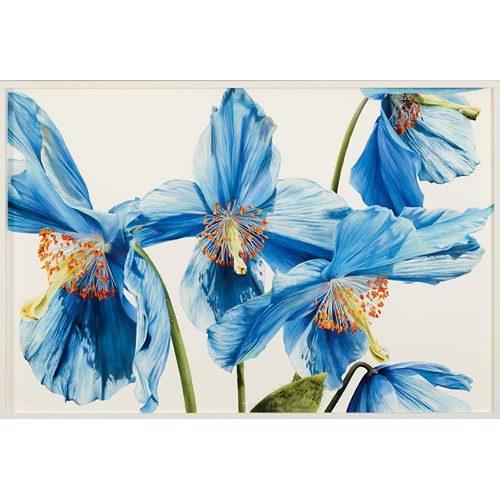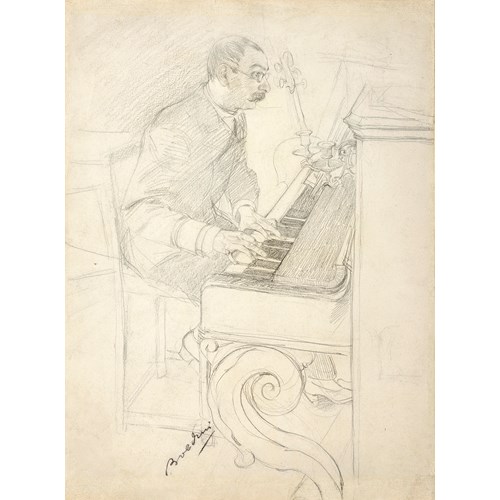Gabriel-Jacques De SAINT-AUBIN
Sheet of Studies of Several Women, One Nursing a Baby, with an Artist Drawing [recto], Three Women in a Landscape [verso]
Period 1750-1850, 18th century
Origin France
Medium Pen, Brown ink, Watercolour, Graphite and stumping, Grey and brown wash
Dimension 10.1 x 13.4 cm (4 x 5¹/₄ inches)
The verso in pen and grey ink and grey wash, with touches of watercolour.
Probably once part of a small sketchbook, this double-sided sheet is likely to date from the decade of the 1760s. As Suzanne McCullagh has noted, Gabriel de Saint-Aubin ‘created a number of study sheets in the 1760s that reflect either the methods of Watteau or the time-honored use of drawings to prepare for paintings. A number of Saint-Aubin’s most charming and informal sketchbook pages juxtaposing various figurative studies – occasionally different views of the same figure – can be dated to this period. Usually executed in black chalk, occasionally heightened with other media, such miscellaneous sketches imitate Watteau’s unusual practice of artfully arranging intimate chalk studies of figures across a sheet of paper. It is rare that Saint-Aubin’s seemingly random observations can be linked to a finished composition.’ Several drawings of this type appear in a sketchbook, known as the Groult album, used by Saint-Aubin between 1759 and 1778 and today in the Louvre.
Furthermore, as the Saint-Aubin scholar Kim de Beaumont adds, ‘Gabriel’s composite drawings, combining disparate images and inscriptions into enigmatically cohesive entities, are among the most distinctive in his oeuvre…Yet they present extraordinary challenges for scholars. Identifying each element of the drawings is, in itself, an ambitious, often not entirely feasible, undertaking, particularly with regard to fragmentary details depicted out of context…Understanding why the artist chose to bring these particular elements together, assuming it is possible to discern a pattern of selection, is a still more daunting task.’
A particularly interesting feature of the various studies on the recto of the present sheet is the portrait of what appears to be an artist in the act of drawing, at the lower right. Could this be Gabriel’s younger brother, Augustin de Saint-Aubin (1736-1807), or his nephew Germain-Auguste de Saint-Aubin, the son of his brother Charles-Germain? As Mary Tavener Holmes has noted, ‘Although portraits form a relatively small percentage of Saint-Aubin’s enormous output, those we have, both drawn and etched, are very affecting, with an emotional transparency and engaging blend of genre and portrait. The sitters were often participants in the world of art and theater or members of his large family.’
According to Edmond and Jules de Goncourt, the present sheet was part of an album of 116 drawings by both Gabriel and Augustin de Saint-Aubin - numbering 97 studies by the former and 19 by the latter – at one time in the collection of the ceramicist Auguste Delaherche (1857-1940). When the album appeared at the 1893 sale of the collection of Hippolyte Destailleur (1822-1893), the present sheet was described as ‘a grouping of six heads of men, women, [and] children, among whom is a woman who is nursing her child...On the verso of this sketch, which has the grace and appearance of a drawing by Watteau, [is] a group of women in a park; [a] very curious watercolor.’ The album remained unsold, however, and was reoffered for sale again three years later, when it was broken up and the drawings sold individually; at this time the present sheet, described in the sale catalogue as a ‘charmant croquis’, was sold for 460 francs.
Period: 1750-1850, 18th century
Origin: France
Medium: Pen, Brown ink, Watercolour, Graphite and stumping, Grey and brown wash
Dimension: 10.1 x 13.4 cm (4 x 5¹/₄ inches)
Provenance: From an album of 116 drawings by Gabriel and Augustin de Saint-Aubin in the collection of Auguste Delaherche, Beauvais
Hippolyte Destailleur, Paris
His sale, Paris, Hôtel des Commissaires-Priseurs, 26-27 May 1893, part of lot 112 (‘Recueil de dessins de Gabriel et de Augustin de Saint-Aubin’), as no.39 (‘Réunion de six têtes d’hommes, de femmes, d’enfants, au milieu desquels se trouve une femme qui allaite son enfant…Au vode ce croquis qui a la grâce et l’aspect d’un dessin de Watteau, un groupe de femmes dans un parc; très-curieuse aquarelle.’), the album unsold at 29,000 francs
Destailleur sale, Paris, Hôtel des Commissaires-Priseurs, 19-23 May 1896, lot 861 (‘Réunion de six têtes d’hommes, de femmes, d’enfants, au milieu desquels se trouve une femme qui allaite son enfant. A la pierre d’Italie avec reprises à l’aquarelle et à l’encre de Chine. Charmant croquis. Au vo: Groupe de femmes dans un parc, à l’aquarelle et à la plume. H. 0.100. L. 0.135.’, sold for 460 francs)
Anonymous sale (‘Collection de dessins anciens par G. de St. Aubin, Boucher, Gillot, Greuze, Hubert Robert, Huet, etc.’), Paris, Hôtel Drouot, 26 November 1969, lot 21
Galerie Cailleux, Paris
Private collection, California.
Literature: Edmond and Jules de Goncourt, L’art du dix-huitième siècle, Paris, 1880, p.435 (‘Réunion de six têtes d’hommes, de femmes, d’enfants, au milieu desquels se trouve une femme qui allaite son enfant. Le dessin (H. 10 c., L. 14 c.), execute à la pierre d’Italie, avec des parties reprises à l’aquarelle, et où les frais roses, les doux incarnats gouaches du petit maître se mélent et se confondent avec des roux et des verdâtres harmonieux, a malheureusement la tête de la mère nourrice et d’une autre femme coupée au milieu de la figure. (Collection Delaherche.)’); Émile Dacier, Gabriel de Saint-Aubin: Peintre, dessinateur et graveur (1724-1780), Vol.II: Catalogue raisonné, Paris, 1931, pp.50-51, no.312 (‘Études de femmes, d’hommes et d’enfants’, not illustrated).
More artworks from the Gallery









